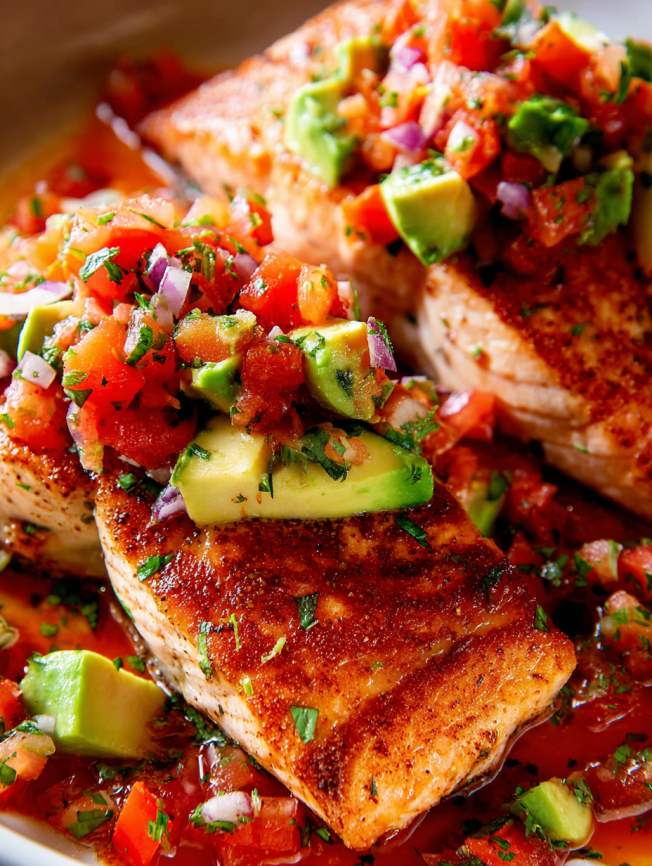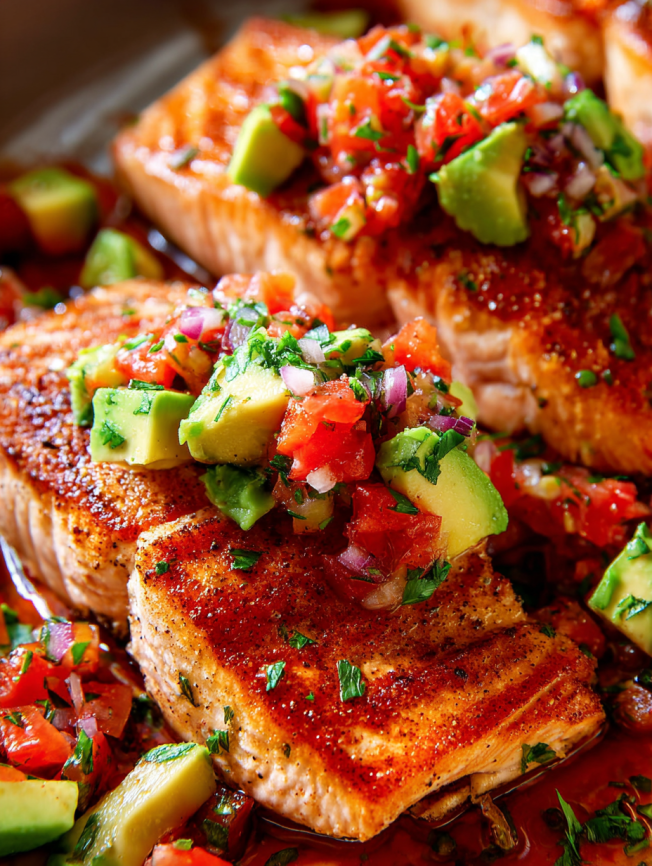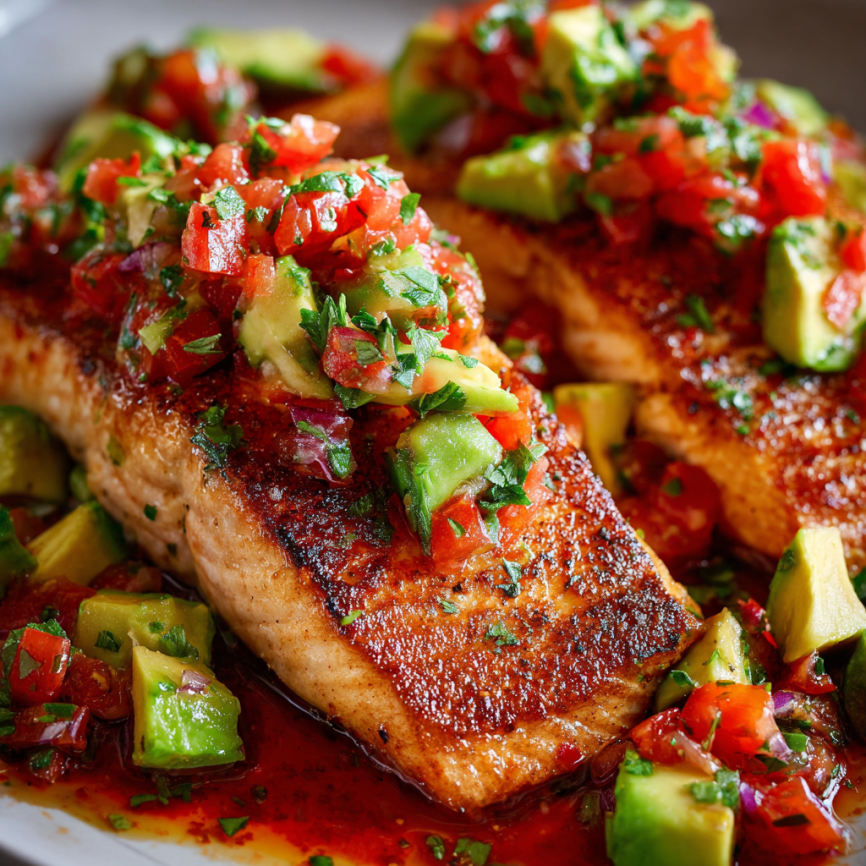The first time I made this dish, I was desperately trying to impress my future in-laws during a dinner party. Armed with little more than hope and a fear of overcooking expensive salmon, I stumbled upon this combination that would become my signature dish. The golden, crispy-skinned salmon paired with the vibrant, fresh salsa created a symphony of flavors that transformed a nerve-wracking evening into a celebration.
What started as a desperate attempt at sophistication has evolved into my go-to recipe for both weeknight dinners and special occasions. The contrast between the rich, buttery salmon and the bright, zesty salsa creates a perfect balance that never fails to impress while remaining surprisingly simple to execute.
Why This Salmon Recipe Will Become Your New Favorite
Perfect Technique Made Accessible
Professional chefs guard their salmon-searing secrets, but this recipe breaks down the process into foolproof steps. The key lies in proper temperature control and timing, ensuring you achieve that coveted golden crust while keeping the interior perfectly tender and flaky.
Nutritional Powerhouse
This dish delivers an impressive nutritional profile with heart-healthy omega-3 fatty acids from the salmon, healthy fats from the avocado, and antioxidants from the fresh tomatoes. Additionally, it’s naturally low-carb and gluten-free, making it suitable for various dietary preferences.
Fresh, Vibrant Flavors
The homemade salsa brings brightness that cuts through the richness of the salmon beautifully. Unlike heavy sauces that mask the fish’s natural flavor, this combination enhances and complements the salmon’s delicate taste.
Quick and Impressive
With just 30 minutes from start to finish, this recipe proves that elegant dining doesn’t require hours of preparation. The visual appeal of golden salmon topped with colorful salsa makes it perfect for entertaining guests.
Ingredients
Prep Time: 15 minutes
Cook Time: 15 minutes
Total Time: 30 minutes
Servings: 4 people
Salmon Components
- 20 ounces skinless salmon fillets (4 fillets, about 5 oz each)
- Salt and pepper to season
- 3 tablespoons lemon juice, divided
- 1 tablespoon olive oil
- 2 tablespoons unsalted butter
- 5 cloves garlic, finely chopped or minced
Fresh Tomato Salsa
- 3 medium tomatoes, finely chopped
- 2 tablespoons red onion, finely chopped
- 1 tablespoon fresh cilantro leaves, finely chopped
- ½ Serrano chile or jalapeño, stems and seeds removed, finely chopped
- 1 small garlic clove, crushed
- 1 tablespoon lime juice
- ¼ teaspoon salt
- 1 large ripe avocado, sliced
Recommended Accompaniments
- Steamed asparagus or green beans
- Coconut rice or quinoa
- Mixed greens salad
- Roasted sweet potatoes
Step-by-Step Instructions
Preparing the Salmon
Remove salmon fillets from the refrigerator at least 15 minutes before cooking to bring them closer to room temperature. This crucial step ensures even cooking throughout the fillet. Pat each fillet completely dry with paper towels, as any moisture will prevent proper searing.
Season all sides generously with salt and pepper, then squeeze 1-2 teaspoons of lemon juice over each fillet. Gently rub the seasonings into the flesh, allowing the acid from the lemon to begin its tenderizing work.
Creating the Perfect Sear
Heat olive oil in a large non-stick pan or stainless steel skillet over medium-high heat until the oil shimmers and moves freely around the pan. Carefully place salmon fillets flesh-side down, pressing lightly to ensure the entire surface makes contact with the hot pan.
Resist the urge to move or check the salmon during this critical phase. Allow the fillets to sear undisturbed for 3-4 minutes until they develop a beautiful golden crust. You’ll know they’re ready to flip when the edges begin to turn opaque and the fillet releases easily from the pan.
Finishing the Salmon
Flip each fillet carefully and sear the other side for exactly 2 minutes. This timing ensures the salmon remains tender and slightly pink in the center. Next, add the butter, chopped garlic, and remaining lemon juice to the pan.
Continue cooking for an additional 1-2 minutes, allowing the butter to brown slightly while stirring it around each fillet. The browning butter, known as beurre noisette, adds a nutty complexity that elevates the entire dish. Taste and adjust seasoning with additional salt, pepper, or lemon juice as needed.
Preparing the Fresh Salsa
While the salmon cooks, combine all salsa ingredients except the avocado in a medium bowl. The timing works perfectly as the flavors meld together during the salmon’s cooking time.
Mix the chopped tomatoes, red onion, cilantro, chile, garlic, lime juice, and salt until well combined. The salsa should be vibrant and chunky, providing textural contrast to the smooth salmon.
Final Assembly
Slice the avocado just before serving to prevent browning. Arrange the avocado slices attractively over each salmon fillet, then generously top with the fresh tomato salsa. Finally, drizzle each portion with the aromatic garlic butter from the pan.

Serving Suggestions
Elegant Plating
Present each salmon fillet on warmed plates with the salsa artfully arranged on top. Drizzle the brown butter around the plate’s edge and garnish with a sprig of fresh cilantro or a lemon wedge.
Family-Style Presentation
Serve the salmon on a large platter with the salsa in a separate bowl, allowing guests to customize their portions. This approach works well for casual gatherings and lets everyone adjust the salsa quantity to their preference.
Complete Meal Pairings
Complement the salmon with sides that won’t compete with its delicate flavor. Consider coconut rice, roasted vegetables, or a simple quinoa pilaf to create a well-rounded, satisfying meal.
Recipe Variations
Spice Level Adjustments
For those who prefer milder flavors, omit the chile entirely or substitute with a pinch of sweet paprika. Conversely, heat lovers can add additional jalapeño or include a dash of hot sauce in the salsa.
Seasonal Salsa Variations
During summer, add diced cucumber or corn kernels to the salsa for extra crunch. In winter, incorporate pomegranate seeds or diced mango for sweetness and color.
Cooking Method Alternatives
While pan-searing creates the best crust, you can also grill the salmon over medium-high heat for 4-5 minutes per side. The salsa pairs equally well with grilled fish and adds a fresh summer element.
Protein Substitutions
This preparation works beautifully with other firm fish like halibut, mahi-mahi, or even chicken breasts. Adjust cooking times accordingly based on thickness and protein type.
Make-Ahead Tips
Salsa Preparation
The tomato salsa can be prepared up to 4 hours in advance and stored in the refrigerator. However, add the avocado only just before serving to prevent browning and maintain the best texture.
Salmon Prep
Season the salmon fillets up to 2 hours ahead and keep them covered in the refrigerator. Remember to remove them 15 minutes before cooking to return to room temperature.
Meal Prep Strategy
While this dish is best served immediately, you can prepare all components in advance and then quickly assemble everything in under 10 minutes for a impressive last-minute meal.
Essential Cooking Notes
Temperature Control Importance
Using room temperature salmon ensures even cooking throughout the fillet. Cold salmon will cook unevenly, resulting in overcooked edges and undercooked centers.
Pan Selection Tips
A non-stick or well-seasoned stainless steel pan works best for achieving the perfect sear. Cast iron retains too much heat and can easily overcook the delicate fish.
Doneness Indicators
Properly cooked salmon should flake easily with a fork but still appear slightly translucent in the center. The internal temperature should reach 145°F (63°C) for food safety, though many prefer it slightly less cooked.
Butter Browning Technique
Watch the butter carefully as it browns – it can go from perfectly nutty to burned in seconds. The ideal color is golden brown with a fragrant, toasted aroma.

Frequently Asked Questions
Q: How do I know when the salmon is perfectly cooked? A: The salmon should flake easily with a fork and appear slightly translucent in the center. The flesh should be opaque pink throughout, and the internal temperature should reach 145°F (63°C).
Q: Can I use frozen salmon for this recipe? A: Yes, but thaw it completely first and pat it very dry. Frozen salmon often contains more moisture, which can interfere with proper searing, so extra drying time is essential.
Q: What’s the best way to prevent the salmon from sticking? A: Ensure your pan is properly heated and the salmon is completely dry before adding it to the pan. Also, don’t move the salmon until it’s ready to flip – it will release naturally when properly seared.
Q: Can I make this recipe without the salsa? A: Absolutely! The salmon with just the garlic butter sauce is delicious on its own. You could also substitute with a simple lemon herb butter or hollandaise sauce.
Q: How do I store leftover salmon? A: Store cooked salmon in the refrigerator for up to 2 days. Reheat gently in a low oven (275°F) to prevent overcooking, or enjoy it cold in salads or grain bowls.
Q: What wine pairs best with this dish? A: A crisp white wine like Sauvignon Blanc, Pinot Grigio, or Chardonnay complements the salmon beautifully. The acidity in these wines balances the richness of the fish and enhances the fresh salsa flavors.
Q: Can I substitute the avocado with something else? A: While avocado adds creaminess and healthy fats, you could substitute with sliced cucumber for crunch, diced mango for sweetness, or simply omit it entirely and let the tomato salsa shine.
Q: Is this recipe suitable for meal prep? A: The salmon is best served immediately, but you can prep the salsa components and season the salmon in advance. Cook the salmon fresh when ready to eat for the best texture and flavor.
Nutrition Information (per serving):
- Calories: 375
- Protein: 30g
- Carbohydrates: 7g
- Fat: 26g
- Fiber: 4g
- Sodium: 224mg

